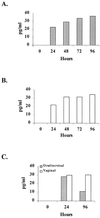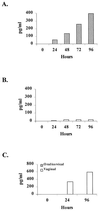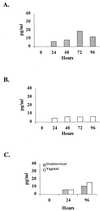Cytokine and chemokine production by human oral and vaginal epithelial cells in response to Candida albicans
- PMID: 11796585
- PMCID: PMC127706
- DOI: 10.1128/IAI.70.2.577-583.2002
Cytokine and chemokine production by human oral and vaginal epithelial cells in response to Candida albicans
Abstract
Oropharyngeal and vaginal candidiases are the most common forms of mucosal fungal infections and are primarily caused by Candida albicans, a dimorphic fungal commensal organism of the gastrointestinal and lower female reproductive tracts. Clinical and experimental observations suggest that local immunity is important in host defense against candidiasis. Accordingly, cytokines and chemokines are present at the oral and vaginal mucosa during C. albicans infections. Since mucosal epithelial cells produce a variety of cytokines and chemokines in response to microorganisms and since C. albicans is closely associated with mucosal epithelial cells as a commensal, we sought to identify cytokines and/or chemokines produced by primary oral and vaginal epithelial cells and cell lines in response to C. albicans. The results showed that proinflammatory cytokines were produced by oral and/or vaginal epithelial cells at various levels constitutively with considerable interleukin-1alpha (IL-1alpha) and tumor necrosis factor alpha, but not IL-6, produced in response to C. albicans. In contrast, Th1-type (IL-12 and gamma interferon) and Th2-type-immunoregulatory (IL-10 and transforming growth factor beta) cytokines and the chemokines monocyte chemoattractant protein 1 and IL-8 were produced in low to undetectable concentrations with little additional production in response to C. albicans. Taken together, these results indicate that cytokines and chemokines are variably produced by oral and vaginal epithelial cells constitutively, as well as in response to C. albicans, and are predominated by proinflammatory cytokines.
Figures



Similar articles
-
Different Host Immunological Response to C. albicans by Human Oral and Vaginal Epithelial Cells.Mycopathologia. 2019 Feb;184(1):1-12. doi: 10.1007/s11046-018-0301-6. Epub 2019 Jan 1. Mycopathologia. 2019. PMID: 30600418
-
Th1/Th2 cytokine expression in saliva of HIV-positive and HIV-negative individuals: a pilot study in HIV-positive individuals with oropharyngeal candidiasis.J Acquir Immune Defic Syndr Hum Retrovirol. 1998 Dec 1;19(4):373-80. doi: 10.1097/00042560-199812010-00008. J Acquir Immune Defic Syndr Hum Retrovirol. 1998. PMID: 9833746
-
Candida albicans and Candida krusei differentially induce human blood mononuclear cell interleukin-12 and gamma interferon production.Infect Immun. 2000 May;68(5):2464-9. doi: 10.1128/IAI.68.5.2464-2469.2000. Infect Immun. 2000. PMID: 10768932 Free PMC article.
-
Immunity to Candida.Oral Dis. 2002;8 Suppl 2:69-75. doi: 10.1034/j.1601-0825.2002.00015.x. Oral Dis. 2002. PMID: 12164664 Review.
-
Initiation of T-helper cell immunity to Candida albicans by IL-12: the role of neutrophils.Chem Immunol. 1997;68:110-35. doi: 10.1159/000058688. Chem Immunol. 1997. PMID: 9329219 Review.
Cited by
-
Innate immunity in the vagina (part I): estradiol inhibits HBD2 and elafin secretion by human vaginal epithelial cells.Am J Reprod Immunol. 2013 May;69(5):463-74. doi: 10.1111/aji.12078. Epub 2013 Feb 8. Am J Reprod Immunol. 2013. PMID: 23398087 Free PMC article.
-
HPV prevalence and concordance in the cervix and oral cavity of pregnant women.Infect Dis Obstet Gynecol. 2004 Jun;12(2):45-56. doi: 10.1080/10647440400009896. Infect Dis Obstet Gynecol. 2004. PMID: 15739817 Free PMC article.
-
Polyanionic microbicides modify Toll-like receptor-mediated cervicovaginal immune responses.Antimicrob Agents Chemother. 2009 Apr;53(4):1490-500. doi: 10.1128/AAC.01152-08. Epub 2009 Jan 12. Antimicrob Agents Chemother. 2009. PMID: 19139286 Free PMC article.
-
Deciphering the role of female reproductive tract microbiome in reproductive health: a review.Front Cell Infect Microbiol. 2024 Mar 18;14:1351540. doi: 10.3389/fcimb.2024.1351540. eCollection 2024. Front Cell Infect Microbiol. 2024. PMID: 38562966 Free PMC article. Review.
-
Shifts in Host Mucosal Innate Immune Function Are Associated with Ruminal Microbial Succession in Supplemental Feeding and Grazing Goats at Different Ages.Front Microbiol. 2017 Aug 30;8:1655. doi: 10.3389/fmicb.2017.01655. eCollection 2017. Front Microbiol. 2017. PMID: 28912767 Free PMC article.
References
-
- Anderson, D. J., J. A. Politch, L. D. Tucker, R. Fichorova, F. Haimovici, R. E. Tuomala, and K. H. Mayer. 1998. Quantitation of mediators of inflammation and immunity in genital tract secretions and their relevance to HIV type 1 transmission. AIDS Res. Hum. Retrovir. 14:S43–S49. - PubMed
-
- Brandtzaeg, P., T. O. Gabrielsen, I. Dale, F. Muller, M. Steinbakk, and M. K. Fagerhol. 1995. The leucocyte protein L1 (calprotectin): a putative nonspecific defense factor at epithelial surfaces. Adv. Exp. Med. Biol. 371:201–206. - PubMed
-
- Cenci, E., A. Mencacci, R. Spaccapelo, L. Tonnetti, P. Mosci, K. H. Enssle, P. Puccetti, L. Romani, and F. Bistoni. 1995. T helper cell type 1 (Th1)- and Th2-like responses are present in mice with gastric candidiasis but protective immunity is associated with Th1 development. J. Infect. Dis. 171:1279–1288. - PubMed
-
- Cenci, E., L. Romani, A. Vecchiarelli, P. Puccetti, and F. Bistoni. 1990. T cell subsets and IFN-gamma production in resistance to systemic candidosis in immunized mice. J. Immunol. 144:4333–4339. - PubMed
Publication types
MeSH terms
Substances
Grants and funding
LinkOut - more resources
Full Text Sources
Other Literature Sources
Research Materials

